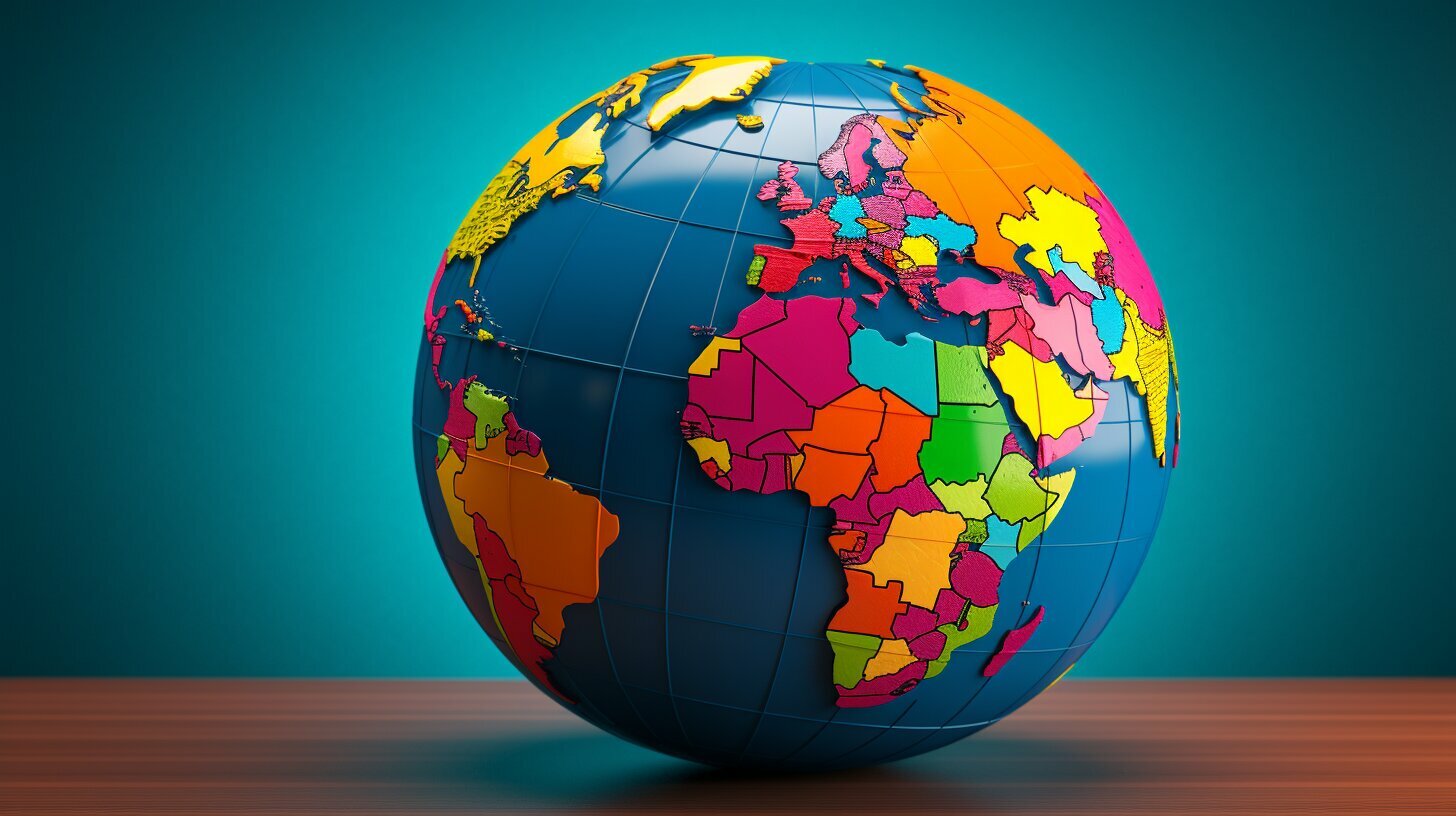When it comes to answering the question “What country is?” there are a multitude of factors to consider, including country locations, identification, and geography.
Key Takeaways:
- There are currently 195 independent sovereign nations in the world.
- 193 of these nations are United Nations members.
- Notable countries include India, China, the United States, and Russia.
- The United Nations recognizes two non-member observer states: the Holy See and the State of Palestine.
- Countries are distributed across regions such as Africa, Asia, Europe, Latin America, the Caribbean, Oceania, and Northern America.
- Each country has its own unique characteristics, including population, languages, and land area.
Understanding the World’s Countries
With a total of 195 independent sovereign nations, including 193 United Nations members, gaining a comprehensive understanding of the world’s countries is essential. From India and China, to the United States and Russia, each nation holds its unique significance on the global stage.
The distribution of countries is diverse, with regions like Africa, Asia, Europe, Latin America, the Caribbean, Oceania, and Northern America each hosting a multitude of nations. Exploring the geography of these regions unveils a rich tapestry of cultures, traditions, and landscapes.
When delving deeper into the characteristics of these countries, we discover fascinating aspects such as their population, languages, and land area. For instance, India stands as the second most populous country in the world, while Russia boasts the largest land area. Embracing the knowledge of these distinctive features enhances our understanding of the world we live in.
Notable Quotes:
“The world is a book and those who do not travel read only one page.” – St. Augustine
Exploring the world’s countries allows us to:
- Expand our knowledge of different cultures and traditions
- Appreciate the diversity that exists worldwide
- Gain insights into the geopolitical landscape of the planet
- Connect with people from various backgrounds and perspectives
| Rank | Country | Population |
|---|---|---|
| 1 | China | 1,439,323,776 |
| 2 | India | 1,366,417,754 |
| 3 | United States | 329,064,917 |
| 4 | Indonesia | 270,625,568 |
| 5 | Pakistan | 216,565,318 |
Notable Countries and Regions
From the vast and diverse nation of India to the economic powerhouse of China, and the political influence of the United States and Russia, certain countries stand out for their global importance. These countries, along with many others around the world, play a significant role in shaping geopolitics, driving economies, and influencing cultural trends.
India, with its rich history, vibrant culture, and massive population, holds a prominent place on the global stage. As one of the world’s largest democracies and fastest-growing economies, India’s contributions in various fields, including technology, arts, and entertainment, cannot be overlooked.
China, on the other hand, boasts the world’s largest population and is known for its rapid economic growth. With its manufacturing prowess, technological advancements, and significant global investments, China has become a force to be reckoned with in international affairs.
The United States and Russia, both major players in global politics, have shaped the course of history in significant ways. The United States, with its immense military power, economic influence, and cultural dominance, remains a key player in shaping international policies. Russia, with its vast land area and rich resources, holds significant political and economic leverage, particularly in its relations with neighboring countries.
Exploring Different Regions
These notable countries are spread across different regions, each with its distinct characteristics and contributions. Africa, with its diverse landscapes and rich cultural heritage, is home to several emerging economies and resource-rich nations. Asia, the largest continent, is a hub for technological innovation, manufacturing, and ancient civilizations. Europe, known for its historical significance and diverse cultures, is a key player in global trade and diplomacy.
Latin America and the Caribbean, with their vibrant cultures and natural beauty, have contributed immensely to the arts, music, and tourism industries. Oceania, encompassing the Pacific Islands, is known for its stunning landscapes and unique ecosystems. Northern America, dominated by the United States and Canada, remains a major global center for innovation, finance, and entertainment.
| Region | Notable Countries |
|---|---|
| Africa | South Africa, Egypt, Nigeria |
| Asia | China, India, Japan |
| Europe | Germany, France, United Kingdom |
| Latin America and the Caribbean | Brazil, Mexico, Argentina |
| Oceania | Australia, New Zealand, Fiji |
| Northern America | United States, Canada, Mexico |
United Nations Membership and Observer States
The United Nations plays a crucial role in international relations, and understanding its membership and observer states is fundamental to understanding global politics. Currently, there are 193 countries that are members of the United Nations, representing the majority of independent sovereign nations in the world. These member states include some of the most populous and influential countries, such as India, China, the United States, and Russia.
In addition to the member states, the United Nations recognizes two non-member observer states. The first is the Holy See, also known as the Vatican City, which is the smallest independent country in the world. Despite its small size, the Holy See has a global presence due to its role as the spiritual and administrative headquarters of the Roman Catholic Church.
The second non-member observer state recognized by the United Nations is the State of Palestine. This recognition acknowledges the aspirations of the Palestinian people for statehood and their ongoing struggle for self-determination. While the status of Palestine as a sovereign state is a matter of ongoing debate and geopolitical complexities, its inclusion as an observer state demonstrates the global recognition of the Palestinian cause.
| United Nations Membership | Observer States |
|---|---|
| 193 member states | 2 observer states |
Understanding the United Nations membership and observer states provides a valuable insight into the complexities of global politics. These countries, both as members and observers, contribute to international decision-making processes and play a significant role in shaping the direction of global affairs. As we explore the world’s countries, their identification, and knowledge, it is essential to recognize the impact that the United Nations and its member and observer states have on our shared future.
Exploring Different Regions
From the vast landscapes of Africa to the bustling cities of Asia, and the diverse cultures of Europe and Latin America, exploring different regions allows us to appreciate the variety of experiences offered by each country. Whether you’re an adventurous traveler or a curious learner, delving into the unique characteristics of these regions will broaden your understanding of the world.
Africa
Africa, the second-largest continent, is home to 54 countries, each with its own rich history and natural wonders. From the iconic pyramids of Egypt to the mesmerizing landscapes of the Serengeti, Africa offers a unique blend of wildlife, landscapes, and vibrant cultures. Whether you’re exploring the bustling markets of Morocco or embarking on a thrilling safari in Kenya, Africa promises unforgettable experiences.
Asia
Asia, the largest and most populous continent, is a melting pot of ancient traditions and modern marvels. From the Great Wall of China to the breathtaking temples of Angkor Wat, Asia showcases a blend of architectural wonders and diverse landscapes. Discover the serenity of Japanese gardens, indulge in the vibrant street food of Thailand, or explore the spirituality of India’s temples and ashrams. Asia offers a myriad of experiences for every traveler.
Europe and Latin America
Europe and Latin America boast a tapestry of cultures, languages, and historical landmarks. In Europe, you can wander the romantic streets of Paris, marvel at the art of Florence, or explore the medieval castles of Eastern Europe. Latin America enchants with its lively festivals, ancient civilizations, and natural wonders like the Amazon rainforest and the Galapagos Islands. Immerse yourself in the vibrancy of Buenos Aires, taste the flavors of Mexican cuisine, or dance the night away in Rio de Janeiro. The possibilities are endless.
| Region | Number of Countries |
|---|---|
| Africa | 54 |
| Asia | 48 |
| Europe | 44 |
| Latin America | 33 |
Exploring different regions allows us to witness the diversity and beauty that countries around the world have to offer. Whether you’re drawn to the vast landscapes of Africa, the bustling cities of Asia, or the rich cultures of Europe and Latin America, each region presents its own unique experiences waiting to be discovered.
Unique Characteristics of Countries
Each country possesses its own distinct characteristics, including its population size, languages spoken, and land area, making them individual and fascinating entities in our global community.
When we think about a country, one of the first questions that often arises is “What country is?” With a total of 195 independent sovereign nations in the world, it’s no wonder that country knowledge and information are in high demand.
Currently, there are 193 United Nations member states, including notable countries like India, China, the United States, and Russia. These nations hold great influence and play a significant role in shaping global affairs.
In addition to the United Nations members, there are two non-member observer states recognized by the organization – the Holy See and the State of Palestine. While not full members, they still have a presence within the international community.
These countries are distributed across different regions, spanning from Africa to Asia, Europe to Latin America, the Caribbean to Oceania, and Northern America. Each region boasts its own unique blend of cultures, traditions, and landscapes.
No two countries are exactly alike. Their populations vary, as do the languages spoken within their borders. Furthermore, the land area of each country differs, ranging from vast expanses to smaller territories.
Exploring the unique characteristics of countries not only expands our country knowledge but also fosters a greater understanding and appreciation of the diverse world we live in. From the smallest island nations to the largest global powers, each country has a story to tell, waiting to be discovered and shared.
FAQ
Q: What are the total number of countries in the world?
A: There are currently 195 independent sovereign nations.
Q: How many countries are members of the United Nations?
A: There are 193 member countries of the United Nations.
Q: Which countries are recognized by the United Nations as non-member observer states?
A: The Holy See and the State of Palestine are recognized as non-member observer states by the United Nations.
Q: In which regions are the countries distributed?
A: The countries are distributed across Africa, Asia, Europe, Latin America, the Caribbean, Oceania, and Northern America.
Q: Can you provide some examples of notable countries?
A: Some notable countries include India, China, the United States, and Russia.
Q: What are some unique characteristics of countries?
A: Each country has its own unique characteristics, including population, languages, and land area.



